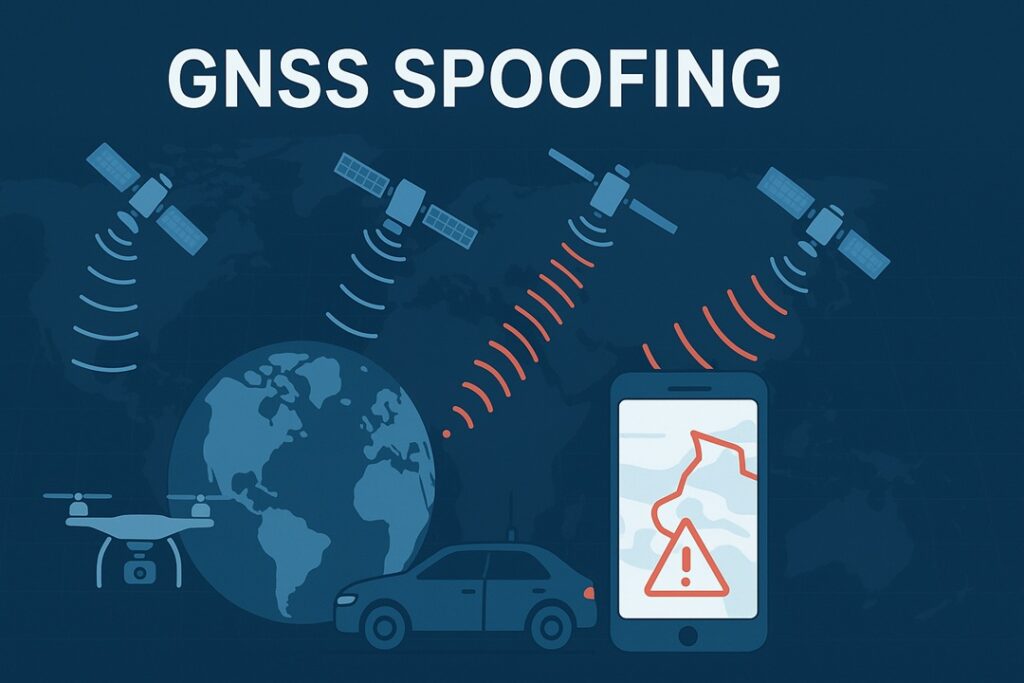GNSS Spoofing Incidents: Emerging Aviation Safety Challenge in India

Context
Aircraft operating near Delhi reported several instances of GNSS spoofing in early November 2025, resulting in false cockpit alerts and misleading terrain warnings.
About GNSS Spoofing
What is GNSS Spoofing
GNSS spoofing refers to the deliberate transmission of counterfeit satellite navigation signals to mislead receivers such as aircraft, ships, drones or vehicles, causing them to calculate incorrect position, time or velocity.
Types of GNSS Interference
GNSS Spoofing (Deception)
Insertion of fake signals to mislead aircraft about location, altitude or direction; considered the most dangerous form of interference.
GNSS Jamming (Signal Blocking)
High-power noise is used to obstruct genuine satellite signals, preventing the receiver from determining its position.
Meaconing (Signal Re-broadcasting)
Authentic signals are captured and retransmitted with a delay, subtly shifting the receiver’s perceived position without obvious alarms.
How GNSS Spoofing Works
Counterfeit Signal Transmission
A nearby transmitter emits fake GNSS signals with slightly higher power than real satellite signals.
Receiver Lock-in
Aircraft navigation systems inadvertently lock onto the counterfeit signals, treating them as authentic.
Gradual Position Drift
Spoofers slowly manipulate the false signals, pulling the computed aircraft position away from reality and generating misleading navigation, terrain or proximity alerts.
Impact on Other Systems
Weapon platforms and drones can also be diverted, misdirected or disabled using similar spoofing techniques.
Characteristics of GNSS Spoofing
Covert and Hard to Detect
Spoofed signals closely resemble genuine GNSS codes, making cockpit warnings ambiguous.
Localized Impact
Effects are typically limited to a few kilometres around the spoofing source.
Slow Position Drift
Gradual manipulation avoids abrupt discrepancies, reducing chances of quick detection.
Triggers False Cockpit Alerts
May generate misleading warnings such as false terrain alerts, runway misalignment or incorrect altitude readings.
Bypasses Basic Anti-Jamming Features
Receivers treat spoofed signals as valid, unlike jamming which produces obvious noise.
Threats Posed by GNSS Spoofing
Loss of Navigation Accuracy
Aircraft may display incorrect positions, wrong headings or misleading flight paths, forcing reliance on manual navigation.
False Terrain and Collision Warnings
Can trigger incorrect terrain alerts or runway alignment errors, especially risky during takeoff and landing.
Increased Pilot Workload and Confusion
Crews must cross-check instruments, verify backups and coordinate with ATC, raising cockpit workload and reducing situational awareness.
Reliance on Backup Systems
Aircraft must shift to Inertial Reference Systems, reliable for hours but not ideal for longer or high-density airspace operations.
Conclusion
GNSS spoofing poses serious risks to aviation safety by degrading navigation reliability and increasing pilot workload during critical flight phases. Strengthening detection systems, deploying advanced anti-spoofing technologies, and enhancing real-time reporting mechanisms are crucial to safeguard airspace operations, especially around high-traffic regions like Delhi.
Source : The Hindu
